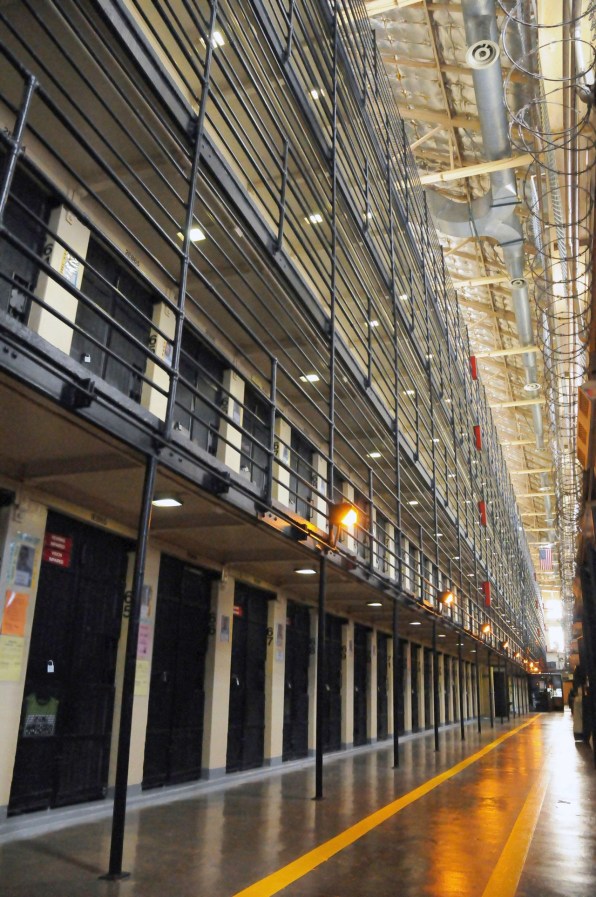In California’s San Quentin State Prison, the toll of the coronavirus has been staggering. More than two-thirds of the prison’s roughly 3,200 inmate population has been infected with the virus, and 25 people there have died, including one guard. According to experts, a major reason the outbreak has been so extreme in San Quentin and at other prisons is their design.
Large residential blocks with hundreds of inmates and little ventilation have exacerbated the spread of COVID-19 in San Quentin, according to a recent report from Amend, a prison transformation program at the University of California, San Francisco, and the UC Berkeley School of Public Health. And though San Quentin dates back to the 1800s, some of its design problems are evident in more recent facilities throughout the state prison system.
Two of San Quentin’s main facilities house 800 men each in tiered blocks of single- and double-occupancy cells five levels high. With no solid walls or floors between them and barred doors exposed to exterior walkways, these tiered spaces are containers of shared air with little or no ventilation. “Windows have been welded shut and the fan system does not appear to have been turned on for years,” the report notes. These are prime conditions for a respiratory pathogen to spread.
Dr. Stefano Bertozzi, dean emeritus and professor of health policy and management at the UC Berkeley School of Public Health, is part of Amend’s COVID in California Prisons Program, and he toured San Quentin and other prisons in the state during the pandemic. He says this multitiered design with little more than metal bars between cells is a remnant of outdated prison design, and only still exists in California in San Quentin and Folsom State Prisons. Other prisons have designs that pack many cells into single buildings, including some with bars for doors, but these tend to house far fewer inmates. “So you’ll have 50 in that environment rather than 750 or 800,” he says. “Fifty is still dangerous, but it’s nowhere near as dangerous as 750 or 800.”

Overcrowding is another issue raised by the recent Amend report, but Bertozzi says the term is often misinterpreted. Some prisons may be overcrowded but at lower risk than a place like San Quentin, which is technically operating slightly over its capacity. “When people say that a prison is overcrowded, they mean that it has more people than the prison was built for. And the cell blocks in San Quentin are designed for 800 men. So it’s not overcrowded unless it’s over 800 men. That doesn’t mean it’s safe in a pandemic, especially a respiratory pandemic,” he says. A prison where single-occupancy cells have been increased to house two people each is technically over capacity, he says, “but it’s not as dangerous as the prison that is 10 dorms of 200 at design capacity.”
During a pandemic, these kinds of large-capacity residential spaces in prisons represent major challenges, according to Amend, which recently conducted another prison study in California’s San Luis Obispo County. “We know what happens when you get congregate settings that are large. You get very large epidemics,” Bertozzi says. “You want to reduce those down to something reasonable. Ten people in a congregate setting and not more than that. And that means reducing the size of many of the dorms in the prisons.”
Along with colleagues from Amend’s COVID in California Prisons Program, Bertozzi has been advising prison officials on immediate changes they should make to reduce risk and increase their ability to respond to outbreaks. They’ve been analyzing the largest residential units at different prisons to determine how much space they’d need to quarantine infected inmates. For some prisons, it’s less than 10 separate cells or tentlike space. For others, it’s more than 1,000—additional housing space that few, if any, facilities are capable of providing.
Though new cases of COVID-19 have slowed in recent weeks at San Quentin, the prison and many others across the state and country are at risk of further outbreaks. Already, prisons across the U.S. are seeing infection rates more than five times higher than the rest of the country. To prevent the situation from getting worse, Amend recommends that prisons enforce mask requirements, social distancing, and increased testing, both of individuals and of housing block sewage systems to detect potential outbreaks before they get out of control. Bertozzi says prisons should also put in place practices that limit exposure among prisoners and staff. Creating small cohorts of staff and prisoners that operate as individual clusters within the prison can ensure that any spread of the virus is small and manageable.
Design is just one of the problems with the prison system as a whole. Acknowledging the role that building prisons plays in perpetuating issues around incarceration, there’s a growing movement among architects and designers to decline taking on prison projects, and the group Architects/Designers/Planners for Social Responsibility has called for a ban on designing “spaces for execution or for torture or cruel, inhuman or degrading treatment.”
Bertozzi says larger systemic issues should also be addressed, both during the pandemic and beyond. First of all, he says forcing people convicted of low-level crimes to begin or continue prison terms during a pandemic creates avoidable risk. “There’s nothing that says people need to serve their time right now. There’s no reason that many many of those people couldn’t serve their time later,” he says. “Now, that’s independent of the fact that in the United States we incarcerate way too many people for way too long compared to any other country in the world. And now’s as good a time as any to address that problem.”








 User Center
User Center My Training Class
My Training Class Feedback
Feedback












Comments
Something to say?
Log in or Sign up for free